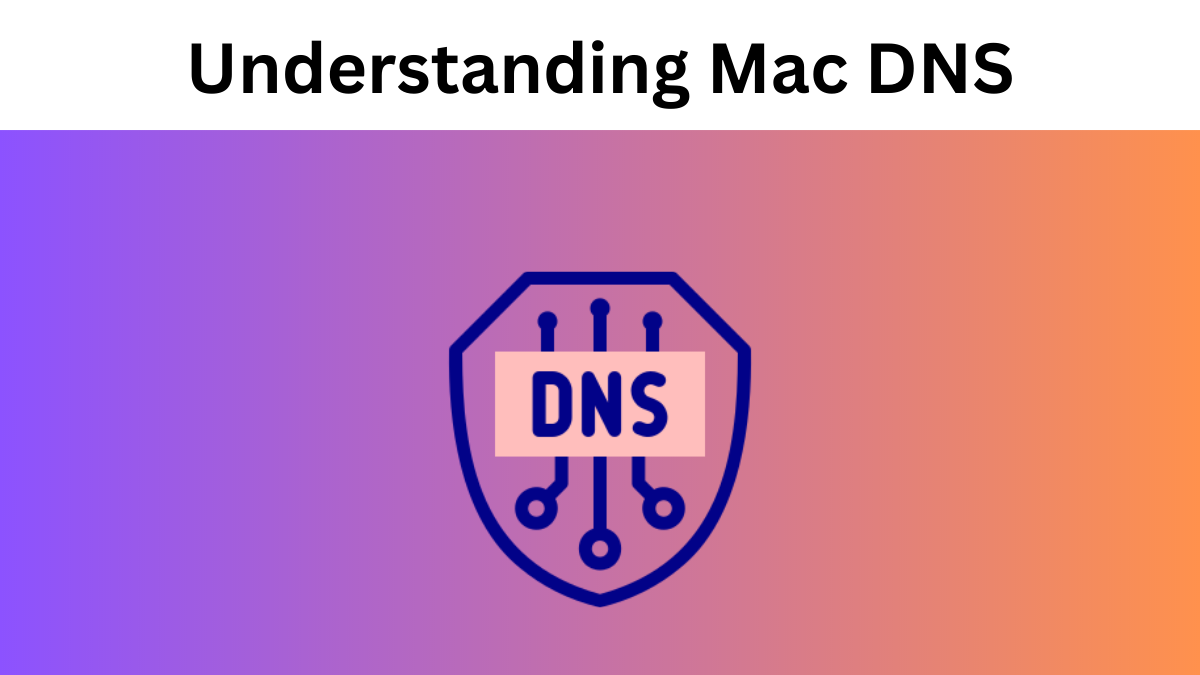Understanding Mac DNS: An Overview of Domain Name System Basics
Computers have a different and special way of identification and communication. They differ from humans, who predominantly rely on names to identify or refer to something. Using the Internet, computers communicate with one another via numerical identifiers known as IP (Internet Protocol) addresses.
This inherent disparity comes with challenges, including communication between machines and humans. To address this issue, networking engineers developed the Domain Name System (DNS)—a remarkable invention that mediates and ensures easy communication between computers and human users.
DNS helps translate familiar domain names into corresponding IP addresses that are easy to understand for computers.
Contents
Want to learn more about DNS? Find out what a Mac DNS is and how it works. We’ll also highlight the key elements that make it an indispensable part of our digital lives.

What is a Mac DNS?
A Domain Name System (DNS) is a crucial backbone of the internet experience. It helps to map domain names to Internet Protocol (IP) addresses. As a Mac user, you can rely on a DNS with search domains to access the websites and servers you frequently visit without typing the full address.
For instance, when you navigate the Internet or access various online resources, you’ll often encounter domain names such as “apple.com.” These names are intuitive and easy for us to remember and recognize. Mac DNS translates these user-friendly domain names into corresponding IP addresses.
As a result, your Mac systems will easily locate and connect to the desired online resources. A Mac DNS links these human-readable domain names and the computer-readable numerical addresses that act as unique identifiers for each networked device.
Understanding How a Mac DNS Works
Picture this: you’re a Mac user and eagerly want to access a website to visit a few days ago. All you have to do is enter its domain name into your web browser. A Mac DNS will help you remember and enter the specific IP address associated with the website you want to access.
It allows you to type the domain name only, and the DNS system will take care of the rest. The DNS will retrieve the corresponding IP address for the domain, allowing your Mac system to establish a connection. This way, it’ll simplify how you interact with the Internet.
The DNS lets you engage in various online activities without directly dealing with the network infrastructure’s intricate numerical addresses.
Domain Name System Basics
You need a Mac DNS for a smooth and user-friendly internet experience. Here are its key basics and how they play a part in ensuring you enjoy better communication and resource accessibility across the digital world.
Mac DNS Resolution
This is the process your macOS performs when you type a website’s domain name into a web browser. Your Mac system will connect with a DNS server to collect the specific IP address linked to the website’s domain name.
The DNS servers will collaborate to locate and provide the right IP address for your requested domain. Mac’s DNS implementation ensures that this process happens smoothly. As a result, you enjoy various online activities such as downloading videos, storing items on the cloud, and more.
Mac DNS Configuration
The internet service provider (ISP) you use is responsible for feeding your Mac systems with DNS servers for domain name resolution needs. However, you can opt for different servers like Google DNS or Cloudflare DNS.
These servers can configure your DNS and tailor your connectivity. All you have to do is master how to configure these Mac DNS settings and enjoy various benefits such as;
- Enhanced internet performance
- Improved security
- Bypass regional restrictions that certain DNS providers might impose.
Boosting Performance with Mac DNS Cache
Mac systems need to have a local DNS cache to expedite the future requests you make and improve network efficiency. The cache keeps and stores information about all the recently accessed domain names and their corresponding IP addresses.
Any moment you make a request, your Mac will easily retrieve the necessary information without initiating a new DNS resolution process. Mac DNS relies on the cache to significantly reduce the time required for subsequent requests. The result is:
- Faster web page loading
- Smoother online interaction
- Overall improved user experience.
However, your Mac DNS cache can get corrupted sometimes, affecting your entire internet experience. When accessing certain websites, you may encounter problems loading sites or recurrent 404 errors. So, it’s always advisable to clear the DNS cache on Mac regularly to avoid experiencing any of these problems.
Remember, clearing the DNS cache can take a different road, depending on your macOS. Choose one that works best for your device.
Mac DNS Security: Safeguarding Your Online Experience
Besides enhancing your network experience, Mac DNS also plays a key role in keeping your online activities safe. Below are some of the crucial security aspects of Mac DNS that you can rely on to protect your data and enhance your overall digital safety.
1. DNS Security Extensions (DNSSEC)
This is a security extension to the DNS protocol. It protects against unauthorized access and data manipulation on your Mac systems. DNSSEC digitally signs DNS records, allowing Mac systems to verify the information received from DNS servers.
This helps prevent various DNS-based attacks, such as DNS cache poisoning or DNS hijacking.
2. DNS over HTTPS (DoH)
The DNS over HTTPS security protocol encrypts DNS traffic to add an extra layer of privacy to all DNS queries. Your Mac system needs this security protocol to encrypt and send DNS requests over an HTTPS connection.
One of the benefits of adopting DNS over HTTPS is that it’ll help improve your Mac’s privacy. It also protects against potential DNS-based surveillance or data leakage.
3. DNS Firewall and Intrusion Detection Systems
DNS Firewalls and Intrusion Detection Systems monitor DNS traffic for suspicious or malicious activities. They perceive and stop DNS-based attacks, including DNS tunneling attempts and distributed denial-of-service (DDoS) attacks.
Final Thoughts
As a Mac user, you need a perfect ecosystem to help you translate user-friendly domains. Mac DNS plays a crucial role in ensuring seamless network connectivity and enhanced online experiences.
But first, you need to understand the fundamentals of Mac DNS to navigate the digital landscape confidently. It will also help you tailor your network connectivity, protect your online activities, and unlock a world of connectivity, accessibility, and online opportunities.
